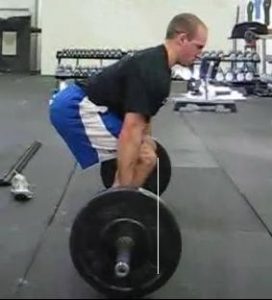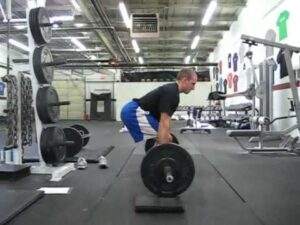
Counterintuitive Coaching: More Loading, Better Learning
It goes without saying that in the overwhelming majority of cases of resistance training technique coaching, adding weight makes it harder to teach an exercise. In other words, we want to deload the movement as a regression, as many trainees get into “panic mode” when you put external load on them. A deadlift that is ugly at 135 pounds is definitely going to look even uglier at 315 pounds.
Lowering the weight is just one regression we can use to optimize technique. Other strategies include changing the exercise (e.g., trap bar deadlift over conventional deadlift), shortening the range of motion (e.g., rack pull vs. deadlift), eliminating fatigue (e.g., dropping a few reps off each set), tinkering with the base of support (e.g., split squat instead of lunging) and deceleration components (e.g., reverse lunges instead of forward lunges). I went into detail on these options and several more in an older article, 11 Ways to Make an Exercise Harder.
Sometimes, however, there are exceptions to these rules. In particular, I’m speaking to the idea that in some cases – as counterintuitive as it may seem – adding weight can actually improve your ability to clean up a movement pattern. Here are a few examples:
Anterior Counterbalance – The best examples to which one can look on this front are the goblet squat and plate-loaded front squat. You can see individuals who have brutal squat patterns that are quickly cleaned up just be giving them some external loading in one of these positions to facilitate an easier posterior weight shift and better core engagement.
Truth be told, this same set-up can be used to improve lateral lunges, too. And, it can also help to explain why some lifters have much better front squat technique than with the back squat.
Olympic lifts – There is definitely a sweet spot for teaching the Olympic lifts, which require a higher speed of execution and “feel” of tension against external load. If you’re teaching them to a more trained athlete with a decent foundation of strength and power, just putting a 5kg training plate on each side of the bar almost never works. The weight is so light that it’s very easy for them to slip into bad patterns like curling the weight or cutting the lower body triple-extension short. Bumping those 5kgs up to 10 or even 20kg bumper plates can make a big difference in syncing everything up.
Deadlifts – While lowering the weight is usually essential for improving deadlift technique, one issue you may encounter is that at very light weights, if you don’t have bumper plates, the plates have a smaller diameter. In other words, lowering the weight below 135 pounds may actually increase the range of motion of the movement. This is easily corrected by elevating those smaller plates on a riser (two aerobic steps works well) or going to a rack pull. However, if strength is adequate, just going to 135 is often the easiest correction, even if it means you need to knock a few reps off the set.

Medicine Ball Work – If a medicine ball is too light, an athlete will do one of two things. First, if it’s a rotational drill, he’ll use too much upper body work and not engage the hips correctly to create powerful rotation to transfer up the chain to the upper body. If it’s an overhead stomp variation, he’ll usually hold back because if the medicine ball is too light, it’ll rebound excessively off the floor and hit him in the face before he can react to it. For this reason, we’ll never do overhead stomps with anything less than 8lb medicine balls – and that would be with absolute beginners. Most folks do best with 10-12-pounders.
Turkish Get-up – I’ve evolved in the way that I teach the Turkish Get-up in recent years. In the past, I would teach it unloaded – and would always notice that lifters – especially hypermobile ones – would manage to slip into their faulty patterns really easily without external loading. Adding a kettlebell – even if it’s only 4-8kg – can make a huge difference in keeping trainees more “compact” and under the kettlebell. Effectively, they guard against vulnerable positions that wouldn’t be noticeable if they didn’t have to support a load overhead.
Reactive Neuromuscular Training (RNT) – Popularized by physical therapist Gray Cook, RNT involved using resistance to pull individuals into their dysfunctional pattern in order to increase proprioceptive awareness and build-up antagonist co-contraction. The athlete (or patient in the clinical realm) acquires the kinesthetic awareness to avoid the dysfunctional pattern, and the strength and motor control to resist falling into it. Perhaps the most well known example of adding resistance to teach a good pattern is in using a band to drive valgus (caving in) at the knee during single-leg patterns.
Weighted Baseballs – We’ve used weighted baseballs as part of our throwing programs since 2008 with great results. The reason isn’t just to get contrast between heavy and light to increase arm speed via post-activation potentiation, but also because using weighted implements can actually help to improve arm action and clean up mechanical faults in certain individuals. If a pitcher has a very long or deep arm action, weighted ball throws can help to shorten it up. If a pitcher has a short deceleration pattern (including a big whip-back), doing some weighted ball holds can teach and train a longer, more joint-friendly pattern.
Wrap-up
There are just seven examples of how increasing external loading can actually facilitate teaching, but there are undoubtedly many more that you may already be using on a daily basis without even realizing it. There are many different ways to clean up movement, so don’t ever rule anything out! Feel free to share additional strategies on this front in the comments section below.



